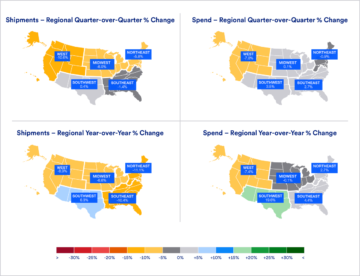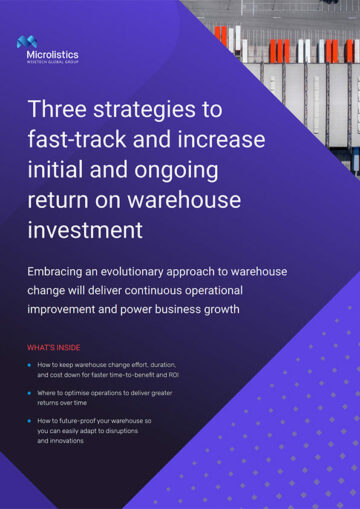
A new study underscores just how widespread concerns about the supply chain are right now. In PwC’s annual survey of more than 4,000 chief executives, 46% of CEOs report adjusting their supply chains in response to recent geopolitical conflict. Those same CEOs are also worried about the effects of climate change, with 78% predicting climate risks will impact their supply chains over the next 12 months.
Businesses have good reason to be concerned. A White House economic report last spring didn’t mince words when it described the supply chain as frail and vulnerable to disruptions caused by war, labor shortages and climate disruptions. Increased geopolitical tensions, environmental challenges and the global economic slowdown have further underscored the need for brands and retailers to be more agile and adopt more comprehensive digital approaches. Digitization has only become more crucial as brands and retailers looking to grow their private label lines have come to rely on vast overseas networks to manufacture their products. The pressures felt on an in-sourced supply chain weigh even heavier on one that’s outsourced and multi-enterprise in nature.
In response to the COVID-19 pandemic, supply chain leaders have stepped up their digital transformation efforts. Those investments will help them to better navigate the obstacles that lie ahead.
In truth, though, most of the steps that brands and retailers have taken haven’t gone far enough. In order to stay price competitive and ensure reliable, on-time product deliveries, businesses that outsource their supply chains need to optimize processes from end to end. That means implementing a multi-enterprise platform that can streamline not only sourcing and product development, but also vendor management, order management, quality management and logistics — all crucial to controlling costs and mitigating risk.
For businesses to successfully weather upcoming disruptions while staying responsive to consumer trends and capitalizing on market opportunities, they must take a unified view of their supply chain planning and strategizing processes. Digitization creates competitive advantages by cutting costs and helping to bring products to market faster, while creating the visibility and agility that brands and retailers need to navigate global challenges and stay ahead of ESG regulations being passed around the world.
The Advantage of Comprehensive Systems
Digitization, of course, is easier said than done. Because hybrid and outsourced supply chains have so many moving parts and stakeholders, businesses find themselves relying on complicated and inefficient networks of sometimes incompatible software, with separate systems covering everything from product development to inspection, inventory management and third-party logistics.
For many major retailers, it’s not uncommon for the same information to be rekeyed two or three times by different departments, and even then it’s often not available to everybody who needs it. Critical information ends up siloed in emails and spreadsheets.
A multi-enterprise platform brings order to supply chain management by connecting all key operations in one shared system, extending data to all stakeholders, and uniting all a business’s systems under one central login. These platforms eliminate redundancies and allow brands and retailers to connect dots and draw intelligent insights from the ever-growing mountains of data they collect, create and manage. The time savings and strategic decision-making these systems enable are increasingly key to preserving profit margins. Since information about product histories, supplier compliance certifications, order details, inspection results, shipping details and much more are all housed under one central repository, they’re always available to all stakeholders and accessible in real time.
Sustainability Demands Digitization
For compliance teams and supply chain sustainability managers, the benefits of digitization are especially profound. Due to recent global regulations such as the U.S. Uyghur Forced Protection Act and Germany’s Supply Chain Due Diligence law, large brands and retailers must now have complete documentation of all their suppliers, from raw materials to finished goods, and they need to be able to document the full chain of custody of materials, including where they were shipped from and where they were made. A multi-enterprise platform creates a single view with all that documentation, while allowing businesses to map their supply chain to the N-tier. That visibility helps safeguard against heavy fines and lengthy detainments.
Brands and retailers that have started their digital transformation have made an important first step toward a more responsible and agile supply chain. But to reap the full benefits of digitization, they need a multi-enterprise platform that covers their supply chain processes from end to end, and they need one that extends their data across all partners and stakeholders seamlessly.
Eric Linxwiler is senior vice president of TradeBeyond.
- SEO Powered Content & PR Distribution. Get Amplified Today.
- Platoblockchain. Web3 Metaverse Intelligence. Knowledge Amplified. Access Here.
- Source: https://www.supplychainbrain.com/blogs/1-think-tank/post/36656-why-supply-chain-digitization-is-no-longer-optional
- :is
- $UP
- 000
- 12 months
- a
- Able
- About
- accessible
- across
- Act
- adopt
- ADvantage
- advantages
- against
- agile
- ahead
- All
- Allowing
- always
- and
- approaches
- ARE
- around
- AS
- available
- Available to all
- BE
- because
- become
- being
- benefits
- Better
- brands
- bring
- Brings
- businesses
- by
- CAN
- capitalizing
- caused
- central
- CEOs
- certifications
- chain
- chains
- challenges
- change
- chief
- Climate
- Climate change
- collect
- come
- competitive
- complete
- compliance
- complicated
- comprehensive
- concerned
- Concerns
- conflict
- Connect
- Connecting
- consumer
- controlling
- Costs
- course
- covering
- covers
- COVID-19
- COVID-19 pandemic
- create
- creates
- Creating
- critical
- crucial
- Custody
- cutting
- data
- Decision Making
- Deliveries
- demands
- departments
- described
- details
- Development
- different
- digital
- Digital Transformation
- digitization
- diligence
- disruptions
- document
- documentation
- easier
- Economic
- effects
- efforts
- eliminate
- emails
- enable
- ends
- enough
- ensure
- environmental
- ESG
- especially
- Even
- ever-growing
- everything
- extending
- far
- faster
- Find
- fines
- First
- For
- from
- full
- further
- geopolitical
- Global
- Global Economic
- good
- goods
- Grow
- Have
- heavy
- help
- helping
- helps
- House
- How
- HTML
- http
- HTTPS
- Hybrid
- Impact
- implementing
- important
- in
- Including
- increased
- increasingly
- inefficient
- information
- insights
- Intelligent
- inventory
- Inventory Management
- Investments
- IT
- jpg
- Key
- Label
- labor
- large
- Last
- Law
- leaders
- lines
- logistics
- longer
- looking
- made
- major
- manage
- management
- Managers
- many
- map
- margins
- Market
- materials
- means
- mitigating
- months
- more
- most
- moving
- Nature
- Navigate
- Need
- needs
- networks
- New
- next
- obstacles
- of
- on
- ONE
- Operations
- opportunities
- Optimize
- order
- outsource
- overseas
- pandemic
- partners
- parts
- passed
- planning
- platform
- Platforms
- plato
- Plato Data Intelligence
- PlatoData
- predicting
- president
- price
- private
- processes
- Product
- product development
- Products
- Profit
- protection
- PWC
- quality
- Raw
- real
- real-time
- reason
- recent
- regulations
- reliable
- rely
- report
- repository
- response
- responsible
- responsive
- Results
- retailers
- Risk
- risks
- s
- Said
- same
- Savings
- seamlessly
- senior
- separate
- shared
- shipped
- Shipping
- shortages
- since
- single
- Slowdown
- So
- Software
- Sourcing
- spring
- stakeholders
- started
- stay
- Step
- Steps
- Strategic
- streamline
- Study
- Successfully
- such
- suppliers
- supply
- supply chain
- supply chain management
- Supply Chain Planning
- Supply chains
- Sustainability
- system
- Systems
- Take
- teams
- that
- The
- the world
- their
- Them
- themselves
- These
- third-party
- three
- time
- times
- to
- toward
- Transformation
- Trends
- u.s.
- Uncommon
- under
- unified
- upcoming
- Vast
- vendor
- Vice President
- View
- visibility
- Vulnerable
- war
- Weather
- weigh
- while
- WHO
- widespread
- will
- with
- words
- world
- worried
- zephyrnet












